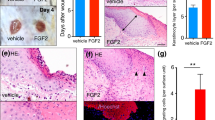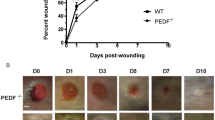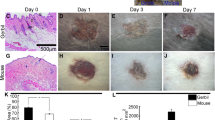Abstract
We investigated the mRNA expression of basic fibroblast growth factor (bFGF) for wound age determination during dermal, cerebral, hepatic and renal wound healing in mice. The bFGF mRNA expression in the injured skin peaked at 1 h and was detected in epidermal cells, fibroblasts, endothelial cells and neutrophils. In the injured cerebrum the expression increased from 1 h and peaked at 48 h. In the intact cerebrum, bFGF was detected exclusively in the endothelial cells, whereas it was also detected in astrocytes during wound healing. Time-dependent expression of bFGF mRNA in skin and cerebrum was considered to be useful for wound age determination. On the other hand it was suggested that bFGF mRNA in astrocytes could be a vital sign of the acute phase. In hepatic and renal injuries, however, bFGF mRNA expression increased slightly in endothelial cells at 24 h, in neutrophils of the liver and in the glomeruli of the kidneys.




Similar content being viewed by others
Reference
Chomczynski P, Sacchi N (1987) Single step method of RNA isolation by acid guanidinium thiocyanate-phenol-chloroform extraction. Anal Biochem 162:156–159
DiProspero NA, Meiners S, Geller HM (1997) Inflammatory cytokines interact to modulate extracellular matrix and astrocytic support of neurite outgrowth. Exp Neurol 148:628–639
Dressler J, Busuttil A, Koch R, et al. (2001) Sequence of melanocyte migration into human scar tissue. Int J Legal Med 115:61–63
Floege J, Eng E, Lindner V, et al. (1992) Rat glomerular mesangial cells synthesize basic fibroblast growth factor, release, upregulated synthesis, and mitogenicity in mesangial proliferative glomerulonephritis. J Clin Invest 90:2362–2369
Gomez-Pinilla F, Vu L, Cotman CW (1995) Regulation of astrocytes proliferation by FGF-2 and heparan sulfate in vivo. J Neurosci 15:2021–2029
Hausmann R, Betz P (2001) Course of glial immunoreactivity for vimentin, tenascin and α1-antichymotrypsin after traumatic injury to human brain. Int J Legal Med 114:338–342
Iwamoto Y, Yamaki T, Murakami N, et al. (1994) Basic fibroblast growth factor messenger RNA is expressed strongly at the acute stage of cerebral contusion. Life Sci 55:1651–1656
Kondo T, Ohshima T, Mori R, et al. (2002) Immunohistochemical detection of chemokines in human skin wounds and its application to wound age determination. Int J Legal Med 116:87–91
Kushihata F, Matsuda S, Sano S, et al. (1997) Expression of basic fibroblast growth factor-like immunoreactivity in the nuclei of regenerating hepatocytes. Cell Tissue Res 288:517–527
Montesano R, Vassalli JD, Raird A (1986) Basic fibroblast growth factor induces angiogenesis in Vitro. Proc Natl Acad Sci U S A 83:7297–7301
Nissen NN, Polverini PJ, Gamelli RL, et al. (1996) Basic fibroblast growth factor mediates angiogenic activity in early surgical wound. Surgery 119: 457–465
Nissen NN, PolveriniPJ, Koch AE, et al. (1998) Vascular endothelial growth factor mediates angiogenic activity during the proliferative phase of wound healing. Am J Pathol 152:1445–1453
Ohshima T, Sato Y (1998) Time-dependent expression of interleukin-10 (IL-10) mRNA during the early phase of skin wound healing as a possible indicator of wound vitality. Int J Legal Med 111:251–255
Raekallio J (1973) Estimation of the age of injuries by histochemical and biochemical methods. Rechtsmedizin 73:83–102
Sato Y, Ohshima T (2000) The expression of mRNA of proinflammatory cytokines during skin wound healing in mice: a preliminary study for forensic wound age estimation. Int J Legal Med 113:140–145
Sato Y, Ohshima T, Kondo T (1999) Regulatory role of endogeneous interleukin-10 in cutaneous inflammatory response of murine wound healing. Biochem Biophys Res Commun 265:194–199
Schweigerer L, Neufeld G, Friedman J (1987) Capillary endothelial cells express basic fibroblast growth factor, a mitogen that promotes their own growth. Nature 325:257–259
Takamiya M, Saigusa S, Aoki Y (2002) Immunohistochemical study of basic fibroblast growth factor and vascular endothelial growth factor expression for age determination of cutaneous wounds. Am J Forensic Med Pathol 23:264–267
Theolet CL, Barber SM, Moyana TM, et al. (2001) Expression of transforming growth factor β1 and β3 and basic fibroblast growth factor in full thickness skin wounds of equine limbs and thorax. Vet Surg 30:269–277
Tuboi R, Rifkin DB (1990) Recombinant basic fibroblast growth factor stimulates wound healing in healing impaired db/db mice. J Exp Med 172:245–251
Villaschi S, Nicosia RF (1993) Angiogenic role of endogeneous basic fibroblast growth factor released by rat aorta after injury. Am J Pathol 143:181–190
Walicke P, Cowan M, Nenu N, et al. (1986) Fibroblast growth factor promotes survival of dissociated hippocampal neurons and enhances neurite extension. Proc Natl Acad Sci U S A 83:3012
Acknowledgements
This study was supported by Grants-in-Aid for General Scientific Research (Y.A; 12670402) from the Ministry of Education, Science, Sports and Culture of Japan.
Author information
Authors and Affiliations
Corresponding author
Rights and permissions
About this article
Cite this article
Takamiya, M., Saigusa, K., Nakayashiki, N. et al. Studies on mRNA expression of basic fibroblast growth factor in wound healing for wound age determination. Int J Legal Med 117, 46–50 (2003). https://doi.org/10.1007/s00414-002-0354-3
Received:
Accepted:
Published:
Issue Date:
DOI: https://doi.org/10.1007/s00414-002-0354-3




